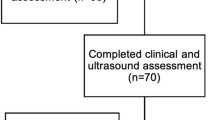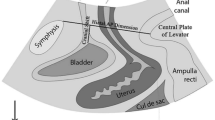Abstract
Purpose
The aim of our study was to investigate 2D and 3D ultrasound assessment of pelvic floor muscle contractility as an objective non-invasive diagnostic tool in urogynecologic patients.
Methods
Patients from our urogynecological outpatient clinic were examined clinically by a single investigator including digital palpation as well as 2D and 3D perineal ultrasound. Muscle contractility was graded according to the modified Oxford Score and ultrasound images were saved for later analysis. Stored images were evaluated offline by another investigator blinded to all clinical data at a later stage. Bladder neck distance from pubic symphysis and symphysis-levator distance were measured in 2D at rest and during maximal pelvic floor muscle contraction. Hiatal area at the level of minimal hiatal dimensions as a 3D ultrasound parameter was measured at rest and during maximal pelvic floor muscle contraction, too. Spearman’s rho was used to calculate statistical correlation between ultrasound parameters and digital assessment.
Results
A total of 114 patients were examined in our study. We found a significant correlation between modified Oxford Score and 2D ultrasound parameters of elongation of bladder neck length (Spearman’s rho 0.292, p = 0.002) and reduction of symphysis-levator distance (Spearman’s rho 0.0.301, p = 0.001), respectively. In addition, we detected a statistical significant correlation of modified Oxford Score and reduction of hiatal area in 3D ultrasound (Spearman’s rho 0.458, p < 0.001), too.
Conclusions
In this study, we found a significant correlation of subjective digital assessment of pelvic floor muscle strength with 2D and 3D ultrasound parameters as an objective diagnostic tool.



Similar content being viewed by others
References
Reisenauer C et al (2013) Interdisciplinary S2e guideline for the diagnosis and treatment of stress urinary incontinence in women: short version—AWMF registry no. 015-005, July 2013. Geburtshilfe Frauenheilkd 73:899–903. doi:10.1055/s-0033-1350871
Braekken IH, Majida M, Ellstrom Engh M, Holme IM, Bo K (2009) Pelvic floor function is independently associated with pelvic organ prolapse. BJOG Int J Obstet Gynaecol 116:1706–1714. doi:10.1111/j.1471-0528.2009.02379.x
Beji NK, Yalcin O, Erkan HA (2003) The effect of pelvic floor training on sexual function of treated patients. Int Urogynecol J Pelvic Floor Dysfunct 14:234–238. doi:10.1007/s00192-003-1071-2 (discussion 238)
Bo K (2012) Pelvic floor muscle training in treatment of female stress urinary incontinence, pelvic organ prolapse and sexual dysfunction. World J Urol 30:437–443. doi:10.1007/s00345-011-0779-8
Lowenstein L, Gruenwald I, Gartman I, Vardi Y (2010) Can stronger pelvic muscle floor improve sexual function? Int Urogynecol J 21:553–556. doi:10.1007/s00192-009-1077-5
Isherwood PJ, Rane A (2000) Comparative assessment of pelvic floor strength using a perineometer and digital examination. BJOG Int J Obstet Gynaecol 107:1007–1011
Mouritsen L, Sander P, Bernstein I, Bach A (1999) Comparison of palpation, ultrasonography and perineometry for examination of the pelvic floor. Int Urogynecol J Pelvic Floor Dysfunct 10(1):16–17 (Abstract)
Bo K, Finckenhagen HB (2001) Vaginal palpation of pelvic floor muscle strength: inter-test reproducibility and comparison between palpation and vaginal squeeze pressure. Acta Obstet Gynecol Scand 80:883–887
van Delft K, Schwertner-Tiepelmann N, Thakar R, Sultan AH (2013) Inter-rater reliability of assessment of levator ani muscle strength and attachment to the pubic bone in nulliparous women. Ultrasound Obstet Gynecol Off J Int Soc Ultrasound Obstet Gynecol 42:341–346. doi:10.1002/uog.12426
van Delft K, Thakar R, Sultan AH (2015) Pelvic floor muscle contractility: digital assessment vs transperineal ultrasound. Ultrasound Obstet Gynecol Off J Int Soc Ultrasound Obstet Gynecol 45:217–222. doi:10.1002/uog.13456
Ferreira CH, Barbosa PB, de Oliveira Souza F, Antonio FI, Franco MM, Bo K (2011) Inter-rater reliability study of the modified Oxford Grading Scale and the Peritron manometer. Physiotherapy 97:132–138. doi:10.1016/j.physio.2010.06.007
Chen R, Song Y, Jiang L, Hong X, Ye P (2011) The assessment of voluntary pelvic floor muscle contraction by three-dimensional transperineal ultrasonography. Arch Gynecol Obstet 284:931–936. doi:10.1007/s00404-010-1795-4
Tunn R et al (2014) Interdisciplinary S2 k Guideline: sonography in Urogynecology: short version—AWMF registry number: 015/055. Geburtshilfe Frauenheilkd 74:1093–1098. doi:10.1055/s-0034-1383044
Martan A, Halaska M, Drbohlav P, Voigt R (1994) [Ultrasound of the urinary bladder neck: changes before and after pelvic floor muscle exercise]. Ceska gynekologie/Ceska lekarska spolecnost. J Ev Purkyne 59:121–124
Dietz HP, Wilson PD, Clarke B (2001) The use of perineal ultrasound to quantify levator activity and teach pelvic floor muscle exercises. Int Urogynecol J Pelvic Floor Dysfunct 12:166–168 (discussion 168–169)
Peschers UM, Gingelmaier A, Jundt K, Leib B, Dimpfl T (2001) Evaluation of pelvic floor muscle strength using four different techniques. Int Urogynecol J Pelvic Floor Dysfunct 12:27–30
Dietz HP, Jarvis SK, Vancaillie TG (2002) The assessment of levator muscle strength: a validation of three ultrasound techniques. Int Urogynecol J Pelvic Floor Dysfunct 13:156–159 (discussion 159)
Thompson JA, O´Sullivan PB, Briffa NL, Neumann P (2006) Assessment of voluntary pelvic floor muscle contraction in continent and incontinent women using transperineal ultrasound, manual muscle testing and vaginal squeeze pressure measurements. Int Urogynecol J Pelvic Floor Dysfunct 17:624–630
Dietz HP (2004) Ultrasound imaging of the pelvic floor. Part II: three-dimensional or volume imaging. Ultrasound Obstet Gynecol Off J Int Soc Ultrasound Obstet Gynecol 23:615–625. doi:10.1002/uog.1072
Braekken IH, Majida M, Ellstrom-Engh M, Dietz HP, Umek W, Bo K (2008) Test-retest and intra-observer repeatability of two-, three- and four-dimensional perineal ultrasound of pelvic floor muscle anatomy and function. Int Urogynecol J Pelvic Floor Dysfunct 19:227–235. doi:10.1007/s00192-007-0408-7
Majida M, Braekken IH, Umek W, Bo K, Saltyte Benth J, Ellstrom Engh M (2009) Interobserver repeatability of three- and four-dimensional transperineal ultrasound assessment of pelvic floor muscle anatomy and function. Ultrasound Obstet Gynecol Off J Int Soc Ultrasound Obstet Gynecol 33:567–573. doi:10.1002/uog.6351
Laycock J (1994) Clinical evaluation of the pelvic floor. In: Schüssler B et al (eds) Pelvic floor re-education: principles and practise. Springer Verlag, London, pp 42–48
Braekken IH, Majida M, Engh ME, Bo K (2009) Test-retest reliability of pelvic floor muscle contraction measured by 4D ultrasound. Neurourol Urodyn 28:68–73. doi:10.1002/nau.20618
Viereck V, Pauer HU, Bader W, Oppermann M, Hilgers R, Gauruder-Burmester A, Lange R, Emons G, Hackenberg R, Krauss T (2004) Introital ultrasound of the lower genital tract before and after colposuspension: a 4-year objective follow-up. Ultrasound Obstet Gynecol Off J Int Soc Ultrasound Obstet Gynecol 23:277–283. doi:10.1002/uog.982
Viereck V, Pauer HU, Hesse O, Bader W, Tunn R, Lange R, Hilgers R, Emons G (2006) Urethral hypermobility after anti-incontinence surgery—a prognostic indicator? Int Urogynecol J Pelvic Floor Dysfunct 17:586–592. doi:10.1007/s00192-006-0071-4
Andrew BP, Shek KL, Chantarasorn V, Dietz HP (2013) Enlargement of the levator hiatus in female pelvic organ prolapse: cause or effect? Aust N Z J Obstet Gynaecol 53:74–78. doi:10.1111/ajo.12026
Dietz HP, Shek C (2008) Levator avulsion and grading of pelvic floor muscle strength. Int Urogynecol J Pelvic Floor Dysfunct 19:633–636. doi:10.1007/s00192-007-0491-9
Wong V, Shek K, Rane A, Goh J, Krause H, Dietz HP (2013) Is levator avulsion a predictor of cystocele recurrence following anterior vaginal mesh placement? Ultrasound Obstet Gynecol 42:230–234. doi:10.1002/uog.12433
Dietz HP, Chantarasorn V, Shek KL (2010) Levator avulsion is a risk factor for cystocele recurrence. Ultrasound Obstet Gynecol 36:76–80. doi:10.1002/uog.7678
Weemhoff M, Vergeldt TF, Notten K, Serroyen J, Kampschoer PH, Roumen FJ (2012) Avulsion of puborectalis muscle and other risk factors for cystocele recurrence: a 2-year follow-up study. Int Urogynecol J 23:65–71. doi:10.1007/s00192-011-1524-y
Author information
Authors and Affiliations
Corresponding author
Ethics declarations
Conflict of interest
All authors indicate no financial interest. All authors state that they have had full control of all primary data. We agree to allow the Journal to review our data if requested.
Rights and permissions
About this article
Cite this article
Albrich, S., Steetskamp, J., Knoechel, SL. et al. Assessment of pelvic floor muscle contractility: digital palpation versus 2D and 3D perineal ultrasound. Arch Gynecol Obstet 293, 839–843 (2016). https://doi.org/10.1007/s00404-015-3897-5
Received:
Accepted:
Published:
Issue Date:
DOI: https://doi.org/10.1007/s00404-015-3897-5




